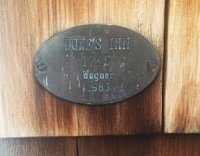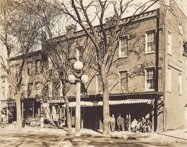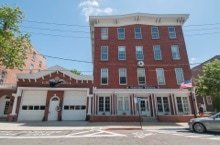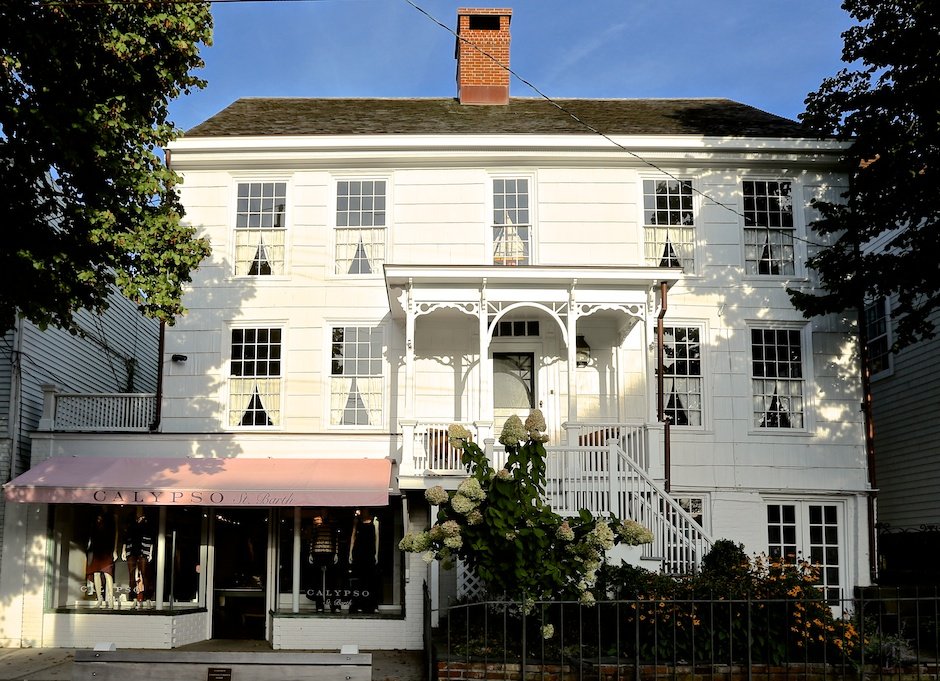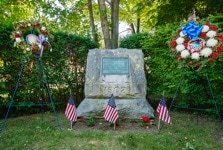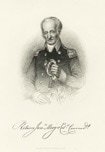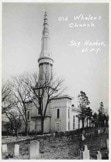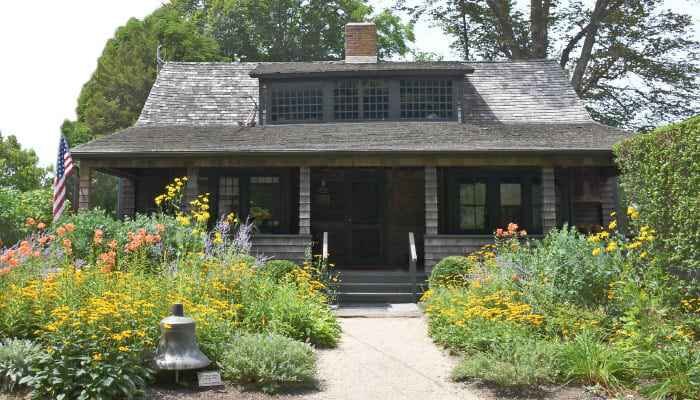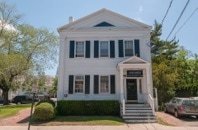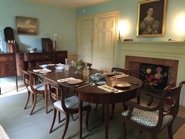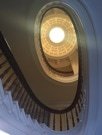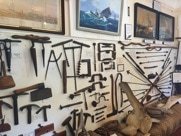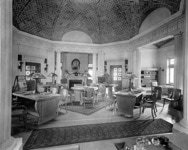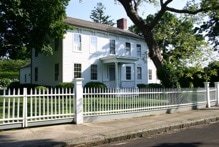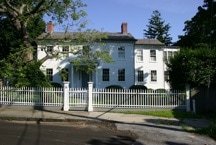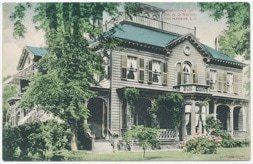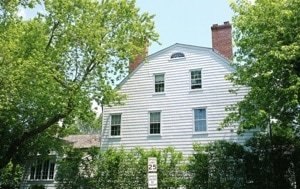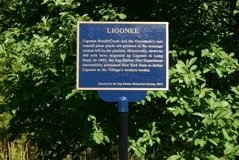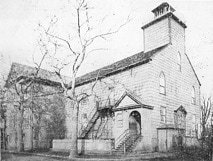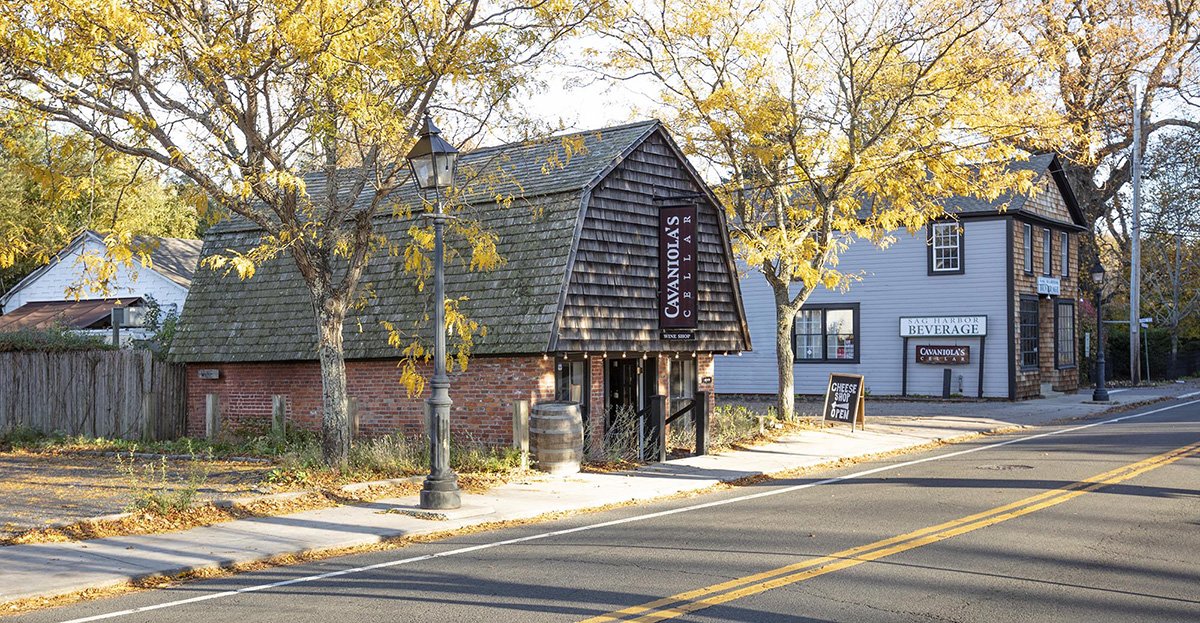SAG HARBOR HISTORICAL SOCIETY
This walking tour of our historic whaling port is offered with the compliments of the
Sag Harbor Historical Society.
*Special thanks to the SHHS for the use of its historic photographs and images, and in particular to Jean Held for her patient generosity.
.
LONG WHARF
Since 1771, Long Wharf has been Sag Harbor’s hub. It was rebuilt and extended for the whaling trade in 1821. Long Wharf is at the north end of Main Street.
In its heyday, ships were lined up six deep, preparing for voyages lasting six months to two years, and traveling as far as the Pacific. From the Wharf to Bay and West Water Streets, the harbor bustled with businesses serving the trade, including sail makers, ropewalks, foundries and coopers.
They all disappeared with the whaling trade, or were snuffed out by notorious fires that engulfed downtown Sag Harbor, notably in 1817, 1845 and 1877. Sag Harbor was an international trading port and in 1789 was designated New York State’s first Port of Entry.
Long Wharf Plaque †
Windmill and Information Center †
Long Wharf’s Active Past *
DUKE FORDHAM’S INN
Be sure to read the two signs; in the median at the base of Long Wharf, and at the SW corner of Main Street and Long Island Avenue, respectively. Note: The Inn was moved to 74 Glover St.
The sign pictured reads:
“Here stands Duke Fordham's Inn, destroyed by the fire of 1845; here James Fenimore Cooper penned his first novel, Precaution, while awaiting the return of the whaleship Union, in which he owned shares along with his uncle, local cooper, Edward Cooper. Precaution was not a best-seller, but it and Cooper’s proceeds from the Union encouraged his further writings, which culminated in The Last of the Mohicans.”
Erected by the Sag Harbor Historical Society
SAG HARBOR GRAIN COMPANY
This brick building on 1A Bay Street, built in 1879, housed the Hampton Flour Mill and replaced the Maidstone Flour Mills destroyed in the great fire of 1877.
The E.W. Bliss Co. administered torpedo testing at nearby Long Beach and Gardiner’s Bay from here both before and during World War I. Later, Agawam and Grumman aircraft-product companies occupied the building and produced parts for the Apollo Lunar Module, which landed in 1969.
1A Bay Street Today †
In Use as a Granary *
E.W. Bliss Torpedo Testing
Lunar Landing Module Above Moon
Railroad Line That Transported Goods
AMERICAN HOTEL and MUNICIPAL BUILDING
These two brick buildings, 55 Main Street, were built in 1846.
The hotel was rebuilt by cabinetmaker Nathaniel Tinker for his business premises after the fire of 1845. The site is thought to be that of the earliest residence in Sag Harbor, James Howell’s Inn, where Colonel Return Jonathan Meigs captured British officers in their beds during the Revolutionary War. The porch, with its columns in the Gothic Revival style, was added across the front when the building was converted to a hotel in 1877.
Next to the American Hotel rose the even more imposing Mansion House Hotel, now the Municipal Building. Ladies spun wool in the ballroom while their husbands traversed the world’s seas. In 1873 it became Sag Harbor’s first comprehensive Union School until 1907, when Pierson High School was built.
American Hotel ‡ years ago
American Hotel ‡ today
Municipal Building years ago
Municipal Building today
ALVIN SILVER COMPANY
ALVIN SILVER COMPANY – See the Historical Marker here near 103 Main Street, which reads:
“This is the site of the Alvin Silver Co., producers of distinctive flatware and hollowware. Along with the Watchcase Factory, Alvin was the Village’s stalwart employer from 1911 to January 1, 1925 when the handsome structure was gutted on New Year’s Day by one of Sag Harbor’s recurrent fires.”
Erected by the Sag Harbor Historical Society
Alvin Silver Company *
Alvin Silver Co. After the Fire of 1925*
PELEG LATHAM HOUSE
Built in 1791 at 177 Main St, this is a typical five-bay, symmetrical Federal-style building with the business beneath the living quarters.
Note the partial Nantucket stairway. Only one of the original two stairways remains.
Latham House ‡
Example of “Nantucket” Stairway
METHODIST CHURCH
At Sage and Main Streets, the church, now a private residence, was built on High Street in 1835 and moved to its more accessible, present location in 1864.
Originally it had a tower clock built by Ephraim Byram. The church was built in the Greek style, and in 1864 an Italianate campanile was added. The front doors were inspired by the famous bronze doors of the Baptistry in Florence, Italy. The top of the campanile blew down in the hurricane of 1938 and was never replaced.
Methodist Church *
Methodist Church Under Reconstruction Today ‡
Watercolor by Walton Roberts *
James Salter (1925 – 2015)
EIGS MONUMENT – West of 44 Union St. you will find a stone monument to Colonel Return Jonathan Meigs.
In 1777, during the Revolutionary War, Meigs captured the British garrison here. He also seized the British officers at James Howell's Inn and destroyed a number of British ships and crucial provisions in the harbor. Meigs operated as a privateer from Connecticut where patriots fled after the Battle of Long Island.
The Island became a British stronghold and the effect of this small but flawless operation was a boost to the Continental Army suffering from a string of recent defeats. This is the site of the Old Arsenal built in anticipation of the War of 1812. Later it served as the Custom House, Post Office and Schoolhouse until it was tom down in 1885.
Salter at Tulane University
Salter Gravestone
'A Sport and a Pastime' by James Salter
mEIGS MONUMENT
West of 44 Union St. you will find a stone monument to Colonel Return Jonathan Meigs.
In 1777, during the Revolutionary War, Meigs captured the British garrison here. He also seized the British officers at James Howell's Inn and destroyed a number of British ships and crucial provisions in the harbor. Meigs operated as a privateer from Connecticut where patriots fled after the Battle of Long Island.
The Island became a British stronghold and the effect of this small but flawless operation was a boost to the Continental Army suffering from a string of recent defeats. This is the site of the Old Arsenal built in anticipation of the War of 1812. Later it served as the Custom House, Post Office and Schoolhouse until it was tom down in 1885.
Meigs’ Monument ‡
Re-enactment of Meigs’ Raid*
Meigs Himself*
Meigs’ Monument with old burying ground behind*
OLD BURYING GROUND
On the hill behind the Meigs Monument, not affiliated with the adjoining Whaler's Church, is the Old Burying Ground. It was established in 1767 for the infant sons of the Howell family.
Soon other prominent early citizens were buried there, such as Beebee, Cooper, Edwards, Fordham, Hand, Havens, Hedges, Hildreth, L'Hommedieu, Rogers, Sayre, Sleight and Wade.
Old Burying Ground ‡
View Toward Old Whalers’ *
Revolutionary War Grave ¶
Clay Schuette Felker
(1925 – 2008)
THE OLD WHALERS' CHURCH (Presbyterian), next to the Old Burying Ground at 44 Union St, was built in 1843-44, and was erected as a monument to the town's whaling prosperity. Designed by noted architect Minard Lafever, the exterior is the best example of the Egyptian Revival style in the U.S. today, and its decoration includes a blubber spade motif along the roofline.
Originally, the church was topped with a 185-foot steeple visible to ships rounding Montauk Point as a welcoming beacon. The steeple was lifted off intact by the 1938 hurricane and smashed into the Old Burying Ground. It was never rebuilt. As recorded by a bronze plaque on the NW corner, the church is the only structure in Sag Harbor designated as a National Historic Landmark.
Old Whalers’ Church Today ‡
Old Postcard *
Men Climbing Steeple *, Steeple Smashed in Old Burying Ground *
JARED WADE HOUSE
Here at the corner of Main and Union Streets stands a modest, center-door, Federal house built by sea captain Jared Wade in 1797. Note the elliptical fanlight over the front door.The foundation is said to be built of ships' ballast.
Jared Wade House
Front Door ‡
STEPHEN FRENCH HOUSE
At 8 Union Street, on high ground, is an Italianate Victorian.
Owner Stephen B. French, a shipping magnate, was active in Republican politics. The house was known as the Summer White House when French's friend, Chester Arthur, was president and summered here. Be sure to read the plaque on the house.
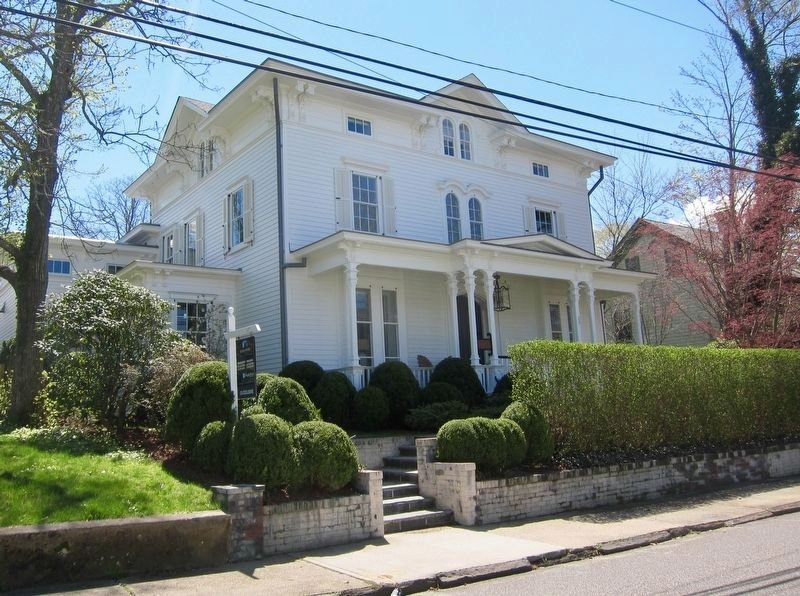
Stephen French House
SAG HARBOR HISTORICAL SOCIETY AND MUSEUM / ANNIE COOPER BOYD HOUSE
This house, tucked back at 174 Main St, is the Annie Cooper Boyd House, one of the oldest houses standing in Sag Harbor (c1796). The porch and dormer were added to the original Cape Cod Colonial in 1906.
Home of artist Annie Cooper Boyd, her lovely images of Sag Harbor and environs grace the walls. The house was left to the Sag Harbor Historical Society & Museum by Annie's daughter, Nancy Boyd Willey, upon her death in 1998. The house is open to the public.
Call 631-725-5092 or visit sagharborhistorical.org Hours: Sat and Sun, May through September: 1-4 pm and by appointment Memorial Day through Columbus Day.
Annie Cooper Boyd House *
Interior ¶
As Tea Room ¶
William Boyd Boat House Interior ¶
STANTON HOUSE & HOPE HOUSE
The Stanton house stands at the division of Madison and Main Streets next to the Hope House. Built in 1840 and 1860 respectively, they are archetypal examples of early Greek Revival and Victorian architecture.
In 1853, Admiral Stanton accompanied Commodore Matthew Perry on his historic visit to Japan which opened up Japan to the West. Benjamin Franklin Hope was a skilled clockmaker.
Stanton House today
Hope House ‡
Stanton House with Methodist Church in Background *
SYBIL DOUGLAS HOUSE
Originally built by ship-owner Benjamin Huntting I on the site of the Whaling Museum, the structure, a classic five-bay Georgian, was sold to Capt. Douglas and moved in 1838 to the opposite side at 189 Main St, when Benjamin Huntting II decided he wanted a more splendid home. Note the handsome front door with its elliptical fanlight and elaborately mullioned side windows, and the ornately carved cornice.
Sybil Douglas House ‡
Douglas House Doorway *
HANNIBAL FRENCH HOUSE
In 1860, the Hannibal French house was redesigned and enlarged from a modest Federal dwelling into a luxurious mansion at 186 Main St by one of the more illustrious whaling/ship-owning families. Note the elaborate Italianate design attributed to architect Minard Lafever.
Despite the decline of the whaling industry, the house was elaborately refurbished as the Hannibal French family fortune remained intact.
Hannibal French House ‡
Hannibal French *
House in Winter *
CUSTOM HOUSE
(1791)
Next to the Hannibal French House and set back from Main Street at Garden Street is the Custom House. This Federal house was moved to its current location in 1948. Originally it stood at the corner of Union and Church Streets and was one of two Custom houses in New York State (the other was in New York City) under Custom Master Henry Packer Dering who was appointed by George Washington. With his shipping partner, Benjamin Huntting I, Dering dispatched the first Sag Harbor whaler to Brazil, thus setting the scene for Sag Harbor's successful whaling fleet.
The Custom House is open to the public. It has been restored by the Society for the Preservation of Long Island Antiquities (SPLIA) and furnished as faithfully as possible, often with original pieces and materials. The Custom House is open daily July and August.
Call 631-692-4664 or visit splia.org/custom-house/
Custom House ‡
Interior
Custom House Being Moved (Photo Credit: SPLIA)
WHALING MUSEUM
200 Main Street: When Benjamin Huntting II sold his father's manse to Captain Sybil Douglas, who moved the manse (the Sybil Douglas House) from this site, he hired Minard Lafever, who was finishing up the Old Whaler's Church, to design a classic, Greek temple-front mansion. It later became the summer home of Mrs. Russell Sage, and the Whaling Museum in 1936. As more than one text states, "a monument to the self-confidence of the successful whaler," with its temple-front portico and fluted Corinthian columns, its blubber-spade decoration along the roofline and whale jawbones framing the front door.
The interior has been renovated and is open to the public as a museum for whaling artifacts and paraphernalia, including a whaleboat in the front yard. It is a splendid example of 19th Century Greek Revival architecture and well worth a visit longer than a pause on our tour.
JOHN JERMAIN MEMORIAL LIBRARY
The Library was opened in 1910 at 201 Main St. It was Mrs. Russell Sage's donation to the Village in honor of her grandfather. With its round granite columns and unique dome, it is an impressive edifice. 100 years later, funds were raised to rehabilitate, enlarge and modernize the building so that John Jermain may continue serving the Village.
Ed. note: The Library's temporary location is now at 34 West Water Street and it is fully functioning.
Library Under Renovation ‡
Old Photo of Interior Under the Dome (Photo credit JJML except for first)
After Hurricane of 1938
Old Postcard of Library
Dome Being Restored
BEEBEE HOUSE
The five-bay Federal façade of the Beebee House sits behind a picket fence at 208 Main St. In whaling days the Beebee House was a farmhouse, and behind it rose cleared land to the crest of what is now Suffolk Street. At the top was the Beebee Mill, and from the second story the miller commanded a view of the bay clear to the Cedar Point Lighthouse.
When he sighted a sail passing the light he would hoist a flag. "Flag on the mill, ship in the bay" went the popular cry and the entire village would throng to the wharf to see who was returning. The mill was moved to Bridgehampton in 1837 where it stands today.
VAN SCOY HOUSE
Corner Jefferson and Main Street. Note the gambrel roof on the Van Scoy house and the ingenious arrangement of windows beneath. It was designed by Sag Harbor’s own carpenter/builder, Benjamin Glover, and occupied by Sag Harbor’s first daguerreotype photographer.
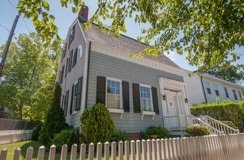
Photo by Michael Heller
MAJOR JOHN JERMAIN OR MRS. RUSSELL SAGE HOUSE
This Federal house (1798) at 221 Main St, with primarily Colonial features, was built by John Jermain who owned all the land to Otter Pond, and after whom Jermain Avenue was named.
Carefully preserved, it was also the family home of Mrs. Russell Sage, a major philanthropist for the village. The Whaling Museum, John Jermain Library, Mashashimuet Park and Pierson High School are among her contributions.
The John Jermain House †
Today and in Bygone Days *
HUNTTING COOPER AND SAMUEL HUNTTING HOUSES
In addition to Benjamin Huntting II there were two other ship-owing Huntting brothers, Gilbert and Samuel. They are responsible for the pair of handsome houses that flank Palmer Terrace on Main Street.
On the north corner at Palmer Terrace, the Huntting Cooper House was built by Gilbert and is one of the more graceful houses in town with its porch, unusual for the period, and a doorway so outstanding that architect Stanford White is said to have offered to buy the entire house just to acquire it. The Samuel Huntting House, at 237 Main St, built circa 1830, is an add-on (a practice common at the time) to a 1797 house built by Dr. Nathaniel Gardner. It is distinguished by both Federal and Greek Revival elements, another handsome door, and unusual wreathed attic windows.
Samuel Huntting House §
Samuel Huntting House Doorway *
Huntting Cooper House §
HOWELL-NAPIER HOUSE
Opposite the Samuel Huntting House is an imposing Italianate mansion recognizable by its widow’s walk. Built in 1790 as a Federal house, it was radically updated to the Italianate in the 1830s when Nathan P. Howell inherited it from his father. Howell’s adopted daughter, who inherited the house, married Alexander Napier. Old photos reveal a more ornate and somewhat forbidding exterior with porches and balconies since discarded.
Howell-Napier House with Old Elaborate Facade *
Howell-Napier House §
L’HOMMEDIEU HOUSE
This brick and brownstone house, at Main north of Glover St, circa 1840, is more redolent of New York City than rural Sag Harbor. Samuel L’Hommediau, grandson of a Huguenot fugitive who operated a ropewalk—a long, narrow building where workers walked back and forth twisting hemp into rope for use in ship's riggings, lines and cables. The ropewalk was situated near Peter’s Green.
L’Hommedieu House Today ‡
An Older Photo in Winter *
GLOVER HOUSE
At the corner of Glover & Main Streets you will find another gambrel-roofed, shingled Federal built by carpenter Benjamin Glover for himself and his family. Note the distinguished front door and porch.
Glover House §
Side View of Gambrel Roof §
PETER'S GREEN
If you walk down Glover Street one short block to Green Street, you will see a sign at the end of Green Street commemorating Peter's Green, a busy commercial neighborhood in early sea-going Sag Harbor (1800s). Turn back to Main Street.
The marker reads:
“At the turn of the 19th Century this was a busy place - Peter’s Green, with Peter Hildreth’s spider-legged mill grinding grain into flour, Samuel L. Hommedieu’s ropewalk, where workers walked twisting yarn into riggings and cables, and Benjamin Wade’s shipyard - the Cove was deeper then and opened into the bay between Sagg Harbour and Hog’s Neck (North Haven).”
Erected by the Sag Harbor Historical Society
Peter’s Green and Marker †
OTTER POND AND JOHN JERMAIN MILL
The pond located on the east side of Main Street between John Street and Jermain Avenue was named for the otters that once frequented its waters. Native Americans camped along its banks. Otter Pond was one in a series of fresh-water ponds between Sagaponack and Sag Harbor.
In 1793 John Jermain was given permission to dig a channel to Sag Harbor Cove rendering Otter Pond partially salt. John Jermain constructed a mill at the site of the current bridge, but the mill failed. Note sign on the Jermain Avenue side of the pond, which reads:
At this place a bridge was constructed in 1793 by John Jermain, holding the water rights by authority of the town of Southampton, a waterway was opened up between Otter Pond and Dayton's Bay (cove) in the same year and fulling mill operations begun.
Great War Memorial at Otter Pond §
Otter Pond §
Old View of Pond from 1878 *
MASHASHIMUET PARK
In 1908, Mrs. Russell Sage purchased and transformed the old trotting and fairgrounds for a park for Sag Harbor's children, and named it Mashashimuet, Algonquian language for "at the great spring." She also acquired Otter Pond. Sports, swimming and ice skating were popular activities. Mashashimuet Park is directly across the street from Otter Pond.
Old View of Entrance *
Park Entrance §
The Park in its Glory as Fairgrounds and Racetrack *
LIGONEE BROOK / CREEK
Five minutes up the Sag Harbor/Bridgehampton Turnpike you fill find Ligonee Brook. The brook, which is the Village's western border, now runs under the road and the park on its course from Long Pond to the Cove.
The sign reads:
“Ligonee Brook/Creek and the Greenbelt’s rare coastal plain ponds are partners in the drainage system left by the glaciers. Historically, alewives and eels have migrated up Ligonee to Long Pond. In 1803, the Sag Harbor Fire Department successfully petitioned New York State to define Ligonee as the Village’s western border.”
Erected by the Sag Harbor Historical Society, 2012
Ligonee Drawing by William Wallace Tooker
Ligonee Marker †
BYRAM HOUSE
On Jermain Avenue at Joel's Lane is an Italianate structure with a campanile. Clockmaker and amateur astronomer Ephraim Byram designed the house in 1852. A Byram grandfather clock stands in the John Jermain Library; other items are at the Whaling Museum, most notably the mechanical model of the solar system. A Byram tower clock is at West Point.
Byram House ‡
Horse Tied in Front of Byram House *
Celestial Globe by Byram ¶
OAKLAND CEMETERY
Opened for burials in 1840, this 10-acre cemetery on Jermain St contains the graves of Capt. David Hand and his five wives. Nearby is the Broken Mast Monument, a moving tribute to whalers who lost their lives "in actual encounter with monsters of the deep." Both are located along the westernmost lane in the cemetery as is the gravesite of ballet master George Balanchine.
Ed. note: The full inscription on the Broken Mast Monument reads:
TO COMMEMORATE
THAT NOBLE ENTERPRISE
THE WHALE FISHERY
AND A TRIBUTE OF LASTING RESPECT
TO THOSE BOLD AND ENTERPRISING SHIP MAST
SONS OF SOUTHAMPTON
WHO PERILED THEIR LIVES
IN A DARING PROFESSION
AND PERISHED IN ACTUAL ENCOUNTER
WITH THE MONSTERS OF THE DEEP.
Entombed in the Ocean. They live in our memory.
Broken Mast Monument
Bas-Relief on Monument (Photo: Jean Held)
Cemetery Entrance §
OAKLAND CEMETERY
Opened for burials in 1840, this 10-acre cemetery on Jermain St contains the graves of Capt. David Hand and his five wives. Nearby is the Broken Mast Monument, a moving tribute to whalers who lost their lives "in actual encounter with monsters of the deep." Both are located along the westernmost lane in the cemetery as is the gravesite of ballet master George Balanchine.
Ed. note: The full inscription on the Broken Mast Monument reads:
TO COMMEMORATE
THAT NOBLE ENTERPRISE
THE WHALE FISHERY
AND A TRIBUTE OF LASTING RESPECT
TO THOSE BOLD AND ENTERPRISING SHIP MAST
SONS OF SOUTHAMPTON
WHO PERILED THEIR LIVES
IN A DARING PROFESSION
AND PERISHED IN ACTUAL ENCOUNTER
WITH THE MONSTERS OF THE DEEP.
Entombed in the Ocean. They live in our memory.
Broken Mast Monument
Bas-Relief on Monument (Photo: Jean Held)
Cemetery Entrance §
TEMPLE ADAS ISRAEL
Located at the corner of Elizabeth Street and Atlantic Avenue, this is the oldest synagogue (1883) in Suffolk and Nassau Counties, established for a congregation of 40-50 Jewish men and their families, who came directly from Ellis Island to work in Fahys Watchcase Factory (the "Bulova Building").
Temple Adas Israel §
Old Photo of the Temple *
A.M.E. ZION CHURCH
The St. David African Methodist Episcopal Zion Church, on Eastville Street just west of Route 114, is a center for African-American residents who separated from the Methodist Episcopal Church in 1840. They erected their own sanctuary and across the street a cemetery. Except for a dozen years in the latter 19th century, it has been active ever since, and much embellished c1891.
Old Photo courtesy Eastville Community Historical Society
AME Zion Church §
EASTVILLE COMMUNITY HISTORICAL SOCIETY
This building, at the corner of Liberty Street and Route 114, was a Sears Roebuck catalogue house delivered by railroad to Sag Harbor in 1925, when there still was a terminal. The Eastville Community Historical Society documents the long history and contributions of African-Americans and Native Americans in Sag Harbor. Return along Route 114 toward the center of town. Just past St. Andrew's Catholic church on left (c1872, enlarged and improved in 1892), turn left on Sage Street, one block to Atheneum Historical Marker.
ECHS Building ¶
“Collective Identity” at Eastville
ATHENEUM
At the NE corner of Sage and Church Streets, a sign designates the original site of the Atheneum.
Ed. note: The Atheneum was a very popular theater in Sag Harbor at the turn of the last century, which was burned to the ground in one of the great fires, and never rebuilt. Anita Miles Shelton Anderson, pictured below, said by her own admission that the performance she gave the night before the theater burned down on April 30, 1924, was so hot that it was partially to blame for starting the fire.
Information from Voices of Sag Harbor: A Village Remembered, 2007, edited by Nina Tobier
Anita Shelton Anderson Dancing *
Thanksgiving Performance at The Atheneum *
The Atheneum *
ATHENEUM
At the NE corner of Sage and Church Streets, a sign designates the original site of the Atheneum.
Ed. note: The Atheneum was a very popular theater in Sag Harbor at the turn of the last century, which was burned to the ground in one of the great fires, and never rebuilt. Anita Miles Shelton Anderson, pictured below, said by her own admission that the performance she gave the night before the theater burned down on April 30, 1924, was so hot that it was partially to blame for starting the fire.
Information from Voices of Sag Harbor: A Village Remembered, 2007, edited by Nina Tobier
Anita Shelton Anderson Dancing *
Old Postcard Showing Atheneum and Colonel Meigs *
Thanksgiving Performance at The Atheneum *
The Atheneum *
FIREMEN'S MUSEUM
The first Presbyterian Church constructed this building for its meeting hall in 1833. In 1856 the Village purchased it to serve as a school, municipal hall and jail. By 1896, it housed the Montauk Hose Co. and Gazelle Hose Co.
Since 1978, when it opened as the Sag Harbor Firemen's Museum at 46 Church St, its exhibits have shown the prominent place fire and firemen have played in Sag Harbor history.
Mural Depicting Fires of 1925 and 1925 ¶
Firemen’s Museum ¶
CAPT. DAVID HAND HOUSE
The David Hand house is next to the Firemen's Museum. Built in Southampton, possibly in the late 17th century, and after several moves, the Capt. David Hand house was located here and occupied by Capt. Hand. Legendary for his fine qualities, Hand was James Fenimore Cooper's model for Natty Bumppo in the Leatherstocking Tales.
David Hand House §
Old Photo of Hand House *
Old Photo of Hand House *
David Hand House §
David Hand House §
Old Photo of Hand House *
BULOVA WATCHCASE FACTORY
In 1880 the Business Aid Committee of Sag Harbor persuaded entrepreneur Joseph Fahys to relocate his watchcase factory from New Jersey to Sag Harbor. Fahys built an immense factory on Route 114 between Sage and Washington Streets that would employ 400 workers and stabilize Village employment for decades – also spawning the successful Alvin Silver Company.
Fahys Watchcase Factory closed in 1931, leaving a gap in employment opportunities. In 1937, Bulova Watch Company located a subsidiary here. That eventually floundered and the building closed in 1980. The building was unoccupied until the early 21st Century, when it was purchased and extensive rehabilitation was begun to convert it into condominiums.
Old Photo of Factory *
Bulova Watchcase Factory Building Today §
UMBRELLA HOUSE
Reputed to be the oldest dwelling in the village, the diminutive Umbrella House (diagonally across the street from the Bulova Building), is so called because of its distinctive roof, thought to have originally been thatched. It has undergone many uses: quartering for British soldiers in 1777; later an arsenal-there are cannon shot scars from the War of 1812; a machinist's shop in the late 19th Century; and an antiques store.
Old Image of Umbrella House *
Umbrella House today §
OLD JAIL HOUSE MUSEUM (1916)
Diagonally across from the Umbrella House is the Old Jail House Museum. Restored by the Sag Harbor Historical Society and opened to the public in 1996, this jail was built to house prisoners more humanely. It houses a collection of police memorabilia and is open to the public by appointment.
Old Jail House Museum *
Jail House Museum in Summer §
BREAKWATER / CORMARIA / HAVENS BEACH
At this locale you will see a marker which reads:
“The Cormaria Retreat House at 77 Bay Street was built by Frank C. Havens for his summer home. In 1902, Havens secured funds from the US Congress to build the Breakwater. Replaced in 2003, the Breakwater continues to protect the harbor from northeast storms. In 1924, Havens’ widow donated waterfront to the east, Havens Beach, as a memorial to her husband.”
Erected by the Sag Harbor Historical Society, 2012
Havens Beach †
Cormaria Retreat House †
Breakwater Marker †






